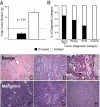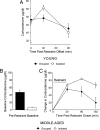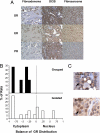Social isolation dysregulates endocrine and behavioral stress while increasing malignant burden of spontaneous mammary tumors
- PMID: 20018726
- PMCID: PMC2799783
- DOI: 10.1073/pnas.0910753106
Social isolation dysregulates endocrine and behavioral stress while increasing malignant burden of spontaneous mammary tumors
Abstract
In a life span study, we examined how the social environment regulates naturally occurring tumor development and malignancy in genetically prone Sprague-Dawley rats. We randomly assigned this gregarious species to live either alone or in groups of five female rats. Mammary tumor burden among social isolates increased to 84 times that of age-matched controls, as did malignancy, specifically a 3.3 relative risk for ductal carcinoma in situ and invasive ductal carcinoma, the most common early breast cancers in women. Importantly, isolation did not extend ovarian function in late middle age; in fact, isolated animals were exposed to lower levels of estrogen and progesterone in the middle-age period of mammary tumor growth, with unchanged tumor estrogen and progesterone receptor status. Isolates, however, did develop significant dysregulation of corticosterone responses to everyday stressors manifest in young adulthood, months before tumor development, and persisting into old age. Among isolates, corticosterone response to an acute stressor was enhanced and recovery was markedly delayed, each associated with increased mammary tumor progression. In addition to being stressed and tumor prone, an array of behavioral measures demonstrated that socially isolated females possessed an anxious, fearful, and vigilant phenotype. Our model provides a framework for studying the interaction of social neglect with genetic risk to identify mechanisms whereby psychosocial stressors increase growth and malignancy of breast cancer.
Conflict of interest statement
The authors declare no conflict of interest.
Figures





Similar articles
-
Enhanced mammary progesterone receptor-A isoform activity in the promotion of mammary tumor progression by dietary soy in rats.Nutr Cancer. 2010;62(6):774-82. doi: 10.1080/01635581.2010.494334. Nutr Cancer. 2010. PMID: 20661826
-
Psychosocial Stress Exposure Disrupts Mammary Gland Development.J Mammary Gland Biol Neoplasia. 2018 Jun;23(1-2):59-73. doi: 10.1007/s10911-018-9392-4. Epub 2018 Apr 23. J Mammary Gland Biol Neoplasia. 2018. PMID: 29687293 Free PMC article.
-
A model of gene-environment interaction reveals altered mammary gland gene expression and increased tumor growth following social isolation.Cancer Prev Res (Phila). 2009 Oct;2(10):850-861. doi: 10.1158/1940-6207.CAPR-08-0238. Epub 2009 Sep 29. Cancer Prev Res (Phila). 2009. PMID: 19789294 Free PMC article.
-
Psychosocial stressors and mammary tumor growth: an animal model.Neurotoxicol Teratol. 2000 Jan-Feb;22(1):89-102. doi: 10.1016/s0892-0362(99)00049-5. Neurotoxicol Teratol. 2000. PMID: 10642118 Review.
-
Prolactin and breast carcinoma.N Engl J Med. 1975 Apr 10;292(15):784-92. doi: 10.1056/NEJM197504102921506. N Engl J Med. 1975. PMID: 1089886 Review.
Cited by
-
Household income is associated with the p53 mutation frequency in human breast tumors.PLoS One. 2013;8(3):e57361. doi: 10.1371/journal.pone.0057361. Epub 2013 Mar 1. PLoS One. 2013. PMID: 23469190 Free PMC article.
-
Personalized breast cancer onset prediction from lifestyle and health history information.PLoS One. 2022 Dec 19;17(12):e0279174. doi: 10.1371/journal.pone.0279174. eCollection 2022. PLoS One. 2022. PMID: 36534670 Free PMC article.
-
Dietary Fructose Consumption and Triple-Negative Breast Cancer Incidence.Front Endocrinol (Lausanne). 2019 Jun 12;10:367. doi: 10.3389/fendo.2019.00367. eCollection 2019. Front Endocrinol (Lausanne). 2019. PMID: 31244777 Free PMC article. Review.
-
Neural mechanisms of social homeostasis.Ann N Y Acad Sci. 2019 Dec;1457(1):5-25. doi: 10.1111/nyas.14016. Epub 2019 Mar 15. Ann N Y Acad Sci. 2019. PMID: 30875095 Free PMC article. Review.
-
Psychosocially influenced cancer: diverse early-life stress experiences and links to breast cancer.Cancer Prev Res (Phila). 2010 Nov;3(11):1365-70. doi: 10.1158/1940-6207.CAPR-10-0238. Epub 2010 Nov 7. Cancer Prev Res (Phila). 2010. PMID: 21084258 Free PMC article.
References
-
- Reiche EM, Nunes SO, Morimoto HK. Stress, depression, the immune system, and cancer. Lancet Oncol. 2004;5:617–625. - PubMed
-
- Lillberg K, et al. Stressful life events and risk of breast cancer in 10,808 women: A cohort study. Am J Epidemiol. 2003;157:415–423. - PubMed
-
- Fox CM, Harper AP, Hyner GC, Lyle RM. Loneliness, emotional repression, marital quality, and major life events in women who develop breast cancer. J Community Health. 1994;19:467–482. - PubMed
-
- Sephton SE, Sapolsky RM, Kraemer HC, Spiegel D. Diurnal cortisol rhythm as a predictor of breast cancer survival. J Natl Cancer Inst. 2000;92:994–1000. - PubMed
Publication types
MeSH terms
Substances
Grants and funding
LinkOut - more resources
Full Text Sources
Other Literature Sources
Research Materials

